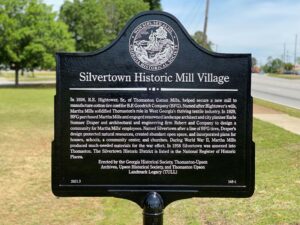May 6, 2021, Atlanta, Georgia – The Georgia Historical Society has announced the unveiling of a new historical marker in Upson County commemorating the Silvertown Historic Mill Village in Thomaston. The village, which was founded by the B.F. Goodrich Company (BFG) in 1929 to house the employees of Martha Mills, created a sense of community for those who manufactured tire cording for BFG. The marker was erected by GHS, Thomaston-Upson Archives, Upson Historical Society, and Thomaston Upson Landmark Legacy (TULL).
Due to the ongoing pandemic, the marker was dedicated in a private ceremony attended by Mrs. Jamesan Gramme, Director of the Thomaston-Upson Archives; The Honorable J.D. Stallings, Mayor of the City of Thomaston; Ms. Sandra Keadle, Keadle Lumber Foundation; Dr. W. Todd Groce, President and CEO of the Georgia Historical Society; Mrs. Kay Hightower, Chairman Emeritus of the Georgia Historical Society; and Lori Showalter Smith, Thomaston-Upson Chamber of Commerce.
“The Silvertown Historic Mill Village marker is a testament to the strong sense of community felt by the residents of Silvertown, both current and past,” says Gramme. “Through the efforts of the B.F. Goodrich Company, the mill village provided employees of Martha Mills and their families with a livelihood, housing, recreation, beautiful landscape, and most importantly, a source of pride. The sense of pride has continued into the present day and with the addition of the historical marker, our community can forever remember what made Silvertown such a unique treasure.”
The marker is located at the historic entryway of Silvertown on the northern crescent of Park Drive in Thomaston, and is the first GHS historical marker erected in Upson County. For further information about the Silvertown Historic Mill Village historical marker or the Georgia Historical Marker Program, please contact Patricia Meagher, GHS Director of Communications at 912.651.2125, ext. 153 or by email at pmeagher@georgiahistory.com.
The marker reads as follows:
Silvertown Historic Mill Village
In 1926, R.E. Hightower, Sr., of Thomaston Cotton Mills, helped secure a new mill to manufacture cotton tire cord for B.F. Goodrich Company (BFG). Named after Hightower’s wife, Martha Mills solidified Thomaston’s role in West Georgia’s thriving textile industry. In 1929, BFG purchased Martha Mills and engaged renowned landscape architect and city planner Earle Sumner Draper and architectural and engineering firm Robert and Company to design a community for Martha Mills’ employees. Named Silvertown after a line of BFG tires, Draper’s design protected natural resources, created abundant open space, and incorporated plans for houses, schools, a community center, and churches. During World War II, Martha Mills produced much-needed materials for the war effort. In 1958 Silvertown was annexed into Thomaston. The Silvertown Historic District is listed in the National Register of Historic Places.
###
ABOUT THE GEORGIA HISTORICAL MARKER PROGRAM
The Georgia Historical Society (GHS) administers Georgia’s historical marker program. Over the past 20 years, GHS has erected nearly 300 new historical markers across the state on a wide variety of subjects. GHS also coordinates the maintenance for more than 2,100 markers installed by the State of Georgia prior to 1998. Online mapping tools allow users to design driving routes based on historical markers, and a mobile app helps visitors locate and learn about markers nearby. Visit georgiahistory.com for more ways to use Georgia’s historical markers and experience history where it happened.
ABOUT THE GEORGIA HISTORICAL SOCIETY
Georgia Historical Society (GHS) is the premier independent statewide institution responsible for collecting, examining, and teaching Georgia history. GHS houses the oldest and most distinguished collection of materials related exclusively to Georgia history in the nation.
To learn more visit georgiahistory.com.

